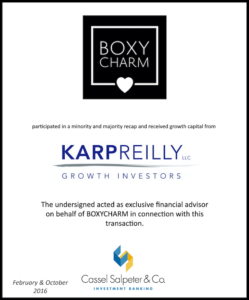 WALTHAM, Mass., Nov. 2, 2016 /PRNewswire/ — Tecogen Inc. (NASDAQ: TGEN) (“Tecogen”) and American DG Energy Inc. (NYSE MKT: ADGE) (“American DG”) today announced that their Boards of Directors unanimously approved a definitive agreement under which Tecogen will acquire all of the outstanding shares of American DG in a stock-for-stock merger. Each share of American DG common stock will be exchanged for 0.092 shares of Tecogen common stock, valuing American DG at an approximately 27% premium to the company’s most recent closing share price. The transaction creates a vertically integrated clean technology company able to offer equipment design, manufacturing, installation, financing, and long term maintenance service. The combined company will retain the Tecogen Inc. name and be led by Co-Chief Executive Officers John Hatsopoulos and Benjamin Locke.
WALTHAM, Mass., Nov. 2, 2016 /PRNewswire/ — Tecogen Inc. (NASDAQ: TGEN) (“Tecogen”) and American DG Energy Inc. (NYSE MKT: ADGE) (“American DG”) today announced that their Boards of Directors unanimously approved a definitive agreement under which Tecogen will acquire all of the outstanding shares of American DG in a stock-for-stock merger. Each share of American DG common stock will be exchanged for 0.092 shares of Tecogen common stock, valuing American DG at an approximately 27% premium to the company’s most recent closing share price. The transaction creates a vertically integrated clean technology company able to offer equipment design, manufacturing, installation, financing, and long term maintenance service. The combined company will retain the Tecogen Inc. name and be led by Co-Chief Executive Officers John Hatsopoulos and Benjamin Locke.
“We are extremely pleased with this transaction and believe that over time it will create significant value for shareholders. I’d like to thank the independent special committees of the boards of both companies for their diligent work to bring this deal to fruition,” said John Hatsopoulos, co-founder, co-CEO, and director of both Tecogen and American DG.
Transaction Rationale and Highlights
- Competitive Advantage– Bringing American DG under the Tecogen umbrella allows Tecogen to offer a cost-free-installation option to customers without access to financing, sufficient capital on hand, or for those who may not be interested in owning and maintaining the equipment – creating a vertically integrated clean technology company better able to compete with other distributed generation peers offering in-house financing arrangements.
- Stable Revenue Base –On a combined basis, approximately half of total company annual revenue is initially expected be from stable, long-term contracted sources (Tecogen Service revenue and American DG Energy revenue). This revenue base will provide a reliable funding source for both operating expense and growth initiatives while also making the combined company’s revenue profile more predictable, reducing the revenue volatility caused by somewhat cyclical equipment sales and installations.
- Growth Potential –Shareholders of the combined company will benefit from Tecogen’s ongoing growth initiatives and joint venture interests, including automotive emissions control joint venture Ultra Emissions Technologies Ltd. (“ULTRATEK”) and cogeneration joint venture TTcogen LLC.
- Cost Savings– The combined companies expect to benefit from approximately $1 million of general and administrative cash savings as duplicative functions are eliminated.
Upon closing of the transaction, Tecogen shareholders are expected to own approximately 81% and American DG shareholders are expected to beneficially own approximately 19% of the combined company. The stock-for-stock transaction is intended to be structured such that it is tax-free to shareholders.
Approvals and Timing
Completion of the transaction is subject to satisfaction of customary closing conditions and the approval of shareholders of both companies. No voting agreements have been entered into in connection with the transaction, and there are no lock-up agreements, no-shop covenants or termination fees contained in the merger agreement. The transaction is expected to close in the first half of 2017.
Advisors
Scarsdale Equities issued a fairness opinion to the Special Committee of the Board established by Tecogen Inc. in connection with the transaction, and White, White and Van Etten, P.C. are acting as the Special Committee’s legal counsel. Cassel Salpeter & Co. is acting as financial advisors to the Special Committee of the Board established by American DG Energy Inc. and Gennari Aronson, LLP is acting as legal counsel to the American DG Special Committee.
Conference Call and Webcast
Tecogen and American DG will take questions regarding this transaction on their third quarter 2016 earnings conference calls hosted Thursday, November 10, 2016. For information about the conference calls please visit:
For Tecogenhttp://investors.tecogen.com/webcasts or http://investors.tecogen.com/2016-10-12-Tecogen-Schedules-Earnings-Release-and-Conference-Call-for-Third-Quarter-2016-Results.
For American DG http://investors.americandg.com/webcast or http://investors.americandg.com/2016-10-14-C-O-R-R-E-C-T-I-O-N-American-DG-Energy-Inc.
About Tecogen
Tecogen® Inc. designs, manufactures, sells, installs, and maintains high efficiency, ultra-clean, cogeneration products including natural gas engine-driven combined heat and power, air conditioning systems, and high-efficiency water heaters for residential, commercial, recreational and industrial use. The company is known for cost efficient, environmentally friendly and reliable products for energy production that, through patented technology, nearly eliminate criteria pollutants and significantly reduce a customer’s carbon footprint.
In business for over 20 years, Tecogen has shipped more than 2,300 units, supported by an established network of engineering, sales, and service personnel across the United States. For more information, please visit www.tecogen.com or contact us for a free Site Assessment.
Tecogen, InVerde, Ilios, Tecochill, Ultera, and e+, are registered trademarks or trademark pending registration of Tecogen Inc.
About American DG Energy
American DG Energy supplies low-cost energy to its customers through distributed power generating systems. We are committed to providing institutional, commercial and small industrial facilities with clean, reliable power, cooling, heat and hot water at lower costs than charged by local utilities – without any capital or start-up costs to the energy user – through our On-Site Utility energy solutions. American DG Energy is headquartered in Waltham, Massachusetts. Learn more about how American DG Energy reduces energy costs at www.americandg.com or follow us on Facebook and Twitter.
Additional Information about the Proposed Transaction and Where to Find It
This press release does not constitute an offer to sell or the solicitation of an offer to buy any securities or a solicitation of any proxy, vote or approval. In connection with the proposed transaction, Tecogen and American DG will prepare and file with the Securities and Exchange Commission (“SEC”) a registration statement on Form S-4 containing a joint proxy statement/prospectus and other documents with respect to the merger. INVESTORS ARE URGED TO READ THE JOINT PROXY STATEMENT/PROSPECTUS (INCLUDING ALL AMENDMENTS AND SUPPLEMENTS THERETO) AND OTHER RELEVANT DOCUMENTS FILED WITH THE SEC IF AND WHEN THEY BECOME AVAILABLE, THESE ITEMS WILL CONTAIN IMPORTANT INFORMATION ABOUT THE PROPOSED TRANSACTION.
Investors may obtain free copies of the registration statement, the joint proxy statement/prospectus and other relevant documents filed by Tecogen and American DG with the SEC (if and when they become available) through the website maintained by the SEC at www.sec.gov. Copies of the documents filed by Tecogen with the SEC will also be available free of charge on Tecogen’s website at www.tecogen.com and copies of the documents filed by American DG with the SEC are available free of charge on American DG’s website at www.americandg.com.
Tecogen, American DG and their respective directors and executive officers may be deemed to be participants in the solicitation of proxies from Tecogen’s and American DG’s shareholders in respect of the proposed transaction. Information regarding Tecogen’s directors and executive officers can be found in Tecogen’s definitive proxy statement filed with the SEC on May 5, 2016. Information regarding American DG’s directors and executive officers can be found in American DG’s definitive proxy statement filed with the SEC on May 13, 2016. Additional information regarding the interests of such potential participants will be included in the joint proxy statement/prospectus and other relevant documents filed with the SECin connection with the proposed transaction if and when they become available. These documents are available free of charge on the SEC’s website and from Tecogen and American DG, as applicable, using the sources indicated above.
Cautionary Language regarding Forward-Looking Statements
This press release includes forward-looking statements within the meaning of Section 27A of the Securities Act of 1933, as amended, and Section 21E of the Securities Exchange Act of 1934, as amended. All statements regarding Tecogen’s, American DG’s or their respective separate or combined future financial position, results of operations, cash flows, funds from operations, business strategy, budgets, projected costs, operating metrics, capital expenditures, competitive positions, acquisitions, investment opportunities, merger integration, growth opportunities, dispositions, plans and objectives of management for future operations and statements that include words such as “anticipate,” “if,” “believe,” “plan,” “estimate,” “expect,” “intend,” “may,” “could,” “should,” “will” and other similar expressions or the negative form of the same are forward-looking statements. Such forward-looking statements are inherently uncertain, and security holders must recognize that actual results may differ from the companies’ expectations. Neither Tecogen nor American DG undertakes a duty to update such forward-looking statements, which speak only as of the date on which they are made.
Tecogen’s and American DG’s actual future results and trends may differ materially depending on a variety of factors discussed in their filings with the SEC. These factors include without limitation: (a) the satisfaction of the conditions to closing the transaction in the anticipated timeframe or at all; (b) the failure to obtain necessary regulatory and stockholder approvals; (c) the ability to realize the anticipated benefits of the transaction; (d) the ability to successfully integrate the businesses; (e) disruption from the transaction making it more difficult to maintain business and operational relationships; (f) the negative effects of this announcement or the consummation of the proposed transaction on the market price of Tecogen’scommon stock; (g) significant transaction costs and unknown liabilities; (h) litigation or regulatory actions related to the proposed transaction; (i) the ability and willingness of each company’s customers to meet and/or perform their obligations under their respective contractual arrangements with the company; (j) the ability of each company to maintain the financial strength and liquidity necessary to satisfy their respective obligations and liabilities to third parties, including without limitation obligations under their existing debt instruments; (k) each company’s success in implementing its business strategy; (l) the nature and extent of future competition and technology developments; (m) the extent of future or pending regulation of the energy sector; (f) the future cost and trends in electricity prices from utilities and other sources; (n) changes in general economic conditions and/or economic conditions in the markets in which each company may, from time to time, compete and the effect of those changes on the company’s revenues and its ability to access the capital markets or other sources of funds; and (o) each company’s ability to pay down, refinance, restructure and/or extend its indebtedness as it becomes due. Many of these factors are beyond the control of the companies and their management.





 WALTHAM, Mass.,
WALTHAM, Mass., Middle-market business owners can improve profitability and customer loyalty by routinely evaluating and enhancing the quality of the experiences their companies provide for two of their most important stakeholders: customers and employees.
Middle-market business owners can improve profitability and customer loyalty by routinely evaluating and enhancing the quality of the experiences their companies provide for two of their most important stakeholders: customers and employees.



